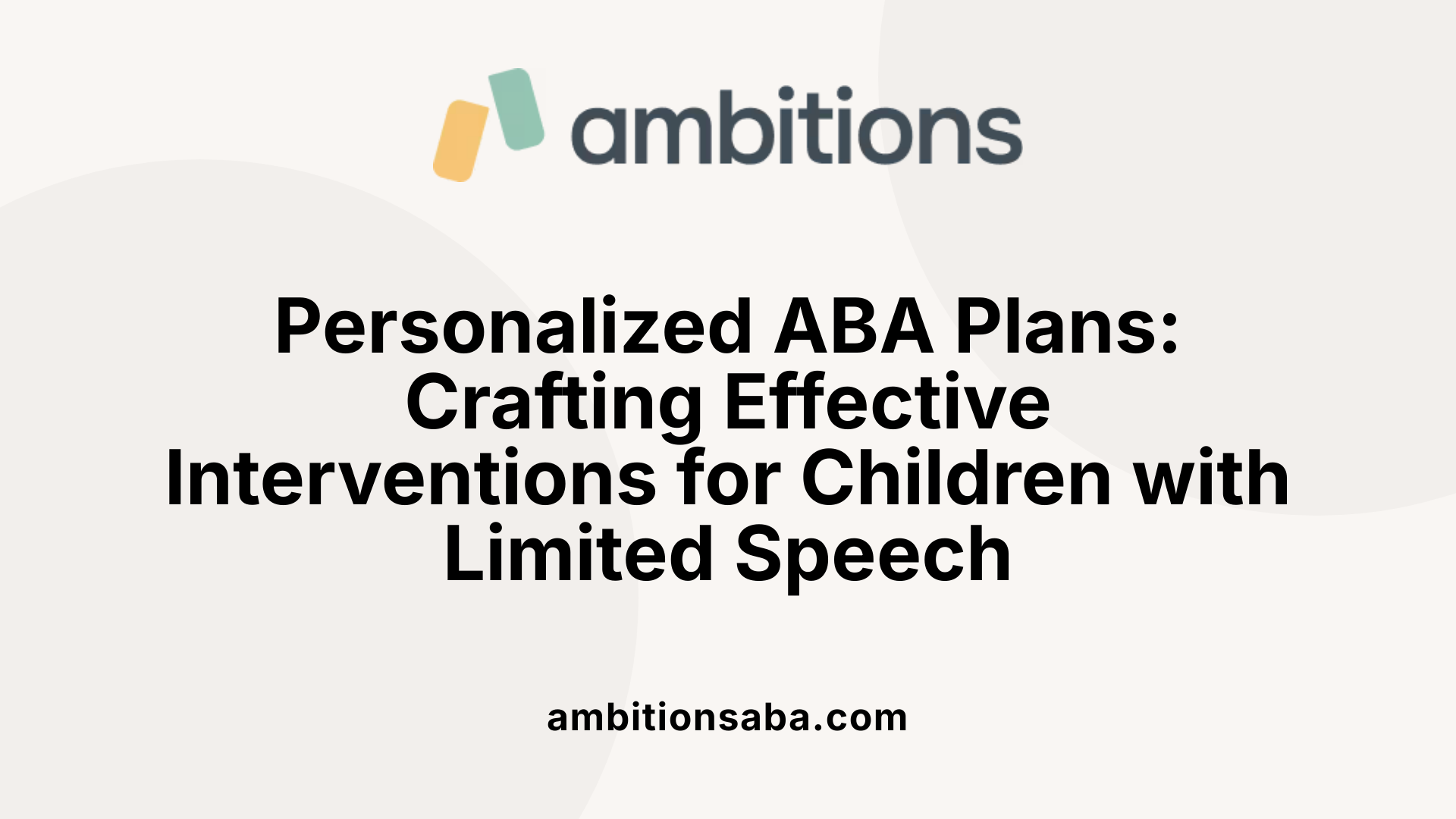Understanding Replacement Behaviors in Autism Therapy: A Key to Successful Outcomes
Understanding ABA Therapy for Nonverbal Children
Applied Behavior Analysis (ABA) therapy is a scientifically validated approach designed to improve behavioral and developmental outcomes in children with autism, particularly those with limited verbal skills. This article explores the principles of ABA, how therapy is tailored for nonverbal children, the role of certified professionals, and the evidence supporting its effectiveness. We also examine practical strategies to support communication development and address potential challenges in therapy implementation.
What Is ABA Therapy and Its Role in Supporting Children with Limited Verbal Skills?

What is Applied Behavior Analysis (ABA) therapy?
Applied Behavior Analysis (ABA) therapy is a science-based treatment approach designed to understand and change behavior by using learning principles. Originating in the 1960s, ABA is primarily used to support children with autism by enhancing helpful behaviors and reducing harmful or non-learning behaviors.
How does ABA therapy focus on behavior modification?
The therapy uses behavioral strategies such as positive reinforcement, where desirable actions are rewarded to increase their occurrence. This reinforces learning and encourages the repetition of beneficial behaviors.
How is ABA therapy tailored to individual needs?
Each ABA program is personalized by certified professionals like Board-Certified Behavior Analysts (BCBAs). They create specific, measurable goals based on an individual's requirements, covering areas like communication, social skills, self-care, play, motor skills, and academics.
How does ABA support children with limited or no verbal communication?
ABA incorporates techniques like discrete trial training and naturalistic teaching strategies to improve both expressive and receptive language skills. For nonverbal children, ABA focuses on building communication through alternative methods and reinforcing appropriate social interactions.
What are the therapy goals for communication and daily living skills?
ABA aims to enhance communication abilities, social interactions, and independence in daily living tasks. This supports children in gaining meaningful skills that improve their quality of life and foster greater independence at home and within their communities.
Qualified Professionals Delivering ABA Therapy: Roles and Credentials

Who Typically Provides ABA Therapy and What Qualifications Do They Have?
ABA therapy is primarily administered by trained professionals such as Board Certified Behavior Analysts (BCBAs), licensed behavior analysts, and behavioral therapists. BCBAs undergo extensive preparation involving a master's degree in applied behavior analysis or a related discipline, completion of 1,500 to 2,000 hours of supervised practical experience, and successful passing of a certification exam. Behavioral therapists supporting ABA interventions often hold specialized training and may hold state certifications or licenses that align with local requirements.
Settings Where Therapy Is Delivered
ABA therapy is versatile and delivered across various environments, including homes, schools, clinics, hospitals, and community settings. This diversity allows therapy to be integrated into the child's daily life, promoting generalization of skills and maximizing real-world applicability.
Role of Certified Professionals in Tailoring and Overseeing Interventions
Certified professionals, especially BCBAs, play a critical role in designing individualized ABA treatment programs. They carefully assess each learner's needs and set specific, measurable goals spanning communication, social skills, and independence. These professionals continuously monitor progress using data-driven methods, adjusting interventions as needed to optimize outcomes. Furthermore, they supervise behavioral therapists and train parents and caregivers to implement strategies consistently across settings, ensuring a cohesive therapeutic approach.
Qualifications and Training of BCBAs and Therapists
Education and credentialing standards ensure ABA practitioners maintain high-quality care. BCBAs must engage in ongoing continuing education and adhere to strict ethical guidelines to maintain their certification. Similarly, behavioral therapists receive specialized instruction in ABA methods and often participate in continuous professional development. This structured training equips them with the tools necessary to apply evidence-based practices effectively.
| Professional Role | Required Qualifications | Responsibilities | Common Work Settings |
|---|---|---|---|
| Board Certified Behavior Analyst (BCBA) | Master's degree, supervised experience (1,500–2,000 hours), certification exam | Designs and oversees personalized ABA programs, monitors progress, trains caregivers | Home, school, clinic, community |
| Behavioral Therapist | Specialized training, certification/licensure varies by region | Implements ABA strategies under BCBA supervision, collects data, supports skill development | Home, clinic, school |
This multi-tiered professional structure ensures that ABA therapy is delivered effectively and tailored precisely to each child's unique needs, fostering meaningful and lasting improvements.
Targeted Behaviors and Skills in ABA for Children with Limited Verbal Abilities

What types of behaviors and skills does ABA therapy focus on improving in individuals with autism?
ABA therapy concentrates on enhancing several critical areas, especially for children with limited verbal abilities. These areas include communication skills, social interaction, self-care routines, play behaviors, and motor skills.
ABA uses positive reinforcement as its primary strategy to encourage helpful behaviors. For example, when a child uses any form of functional communication—whether through gestures, sign language, or simple words—the therapist provides a rewarding response, promoting the repetition and growth of these communicative acts.
Strategies to increase functional communication
To boost functional communication, ABA therapy uses methods like discrete trial training and natural environment teaching. These techniques help children learn how to effectively express needs, make choices, and request assistance.
ABA also targets reducing non-helpful behaviors that may interfere with learning, such as tantrums or self-injury, by understanding the antecedents and consequences surrounding these behaviors (the ABC model) and replacing them with more positive alternatives.
Family involvement for generalization of skills
A vital part of ABA therapy is involving parents and caregivers. They receive training to reinforce newly acquired skills in everyday settings like the home or community. This involvement helps children generalize skills beyond therapy sessions and promotes lasting improvements in communication, social skills, and daily living activities.
This tailored, comprehensive approach enables children with limited verbal abilities to increase functional communication and independence, laying a foundation for better social integration and quality of life.
Designing and Implementing ABA Programs for Children with Limited Verbal Communication

How is an ABA therapy program typically designed and implemented for someone with autism?
ABA programs start with a detailed assessment by a Board-Certified Behavior Analyst (BCBA). They evaluate the child's unique abilities and challenges, especially focusing on communication, social skills, and behaviors. This is essential for children with limited verbal communication to tailor the therapy appropriately.
Setting individualized measurable goals
The BCBA sets clear, personalized goals that are specific and measurable. For children with limited verbal skills, goals often emphasize improving communication through nonverbal means, social interactions, daily living, and play skills. Progress in these areas is monitored closely to ensure effectiveness.
Use of discrete trial training, natural environment teaching, verbal behavior intervention
Several ABA techniques support learning in children with limited speech:
- Discrete Trial Training (DTT): Provides structured, repeated teaching segments that focus on specific skills.
- Natural Environment Teaching (NET): Encourages learning in everyday situations to promote generalization.
- Verbal Behavior Intervention (VBI): Focuses on teaching functional communication, including nonverbal and verbal behaviors.
These approaches are integrated based on individual needs.
Data collection and monitoring progress
Comprehensive data is collected on the child’s responses and behaviors during therapy sessions. This quantitative tracking allows BCBAs and therapists to adjust interventions dynamically, ensuring goals are met effectively.
Role of family and environment in intervention
Families and caregivers play an active role. They receive training to implement strategies consistently at home and in natural settings, reinforcing learning and encouraging skill use beyond therapy sessions.
Adaptations for children with limited verbal skills
Programs use alternative communication methods such as picture exchange, gestures, or assistive technology. Therapy emphasizes understanding the antecedents and consequences of behaviors to teach appropriate responses.
Through these carefully designed, individualized, and dynamic methods, ABA therapy supports meaningful progress in children with limited verbal communication, enhancing their skills and quality of life.
Evidence Supporting ABA Therapy's Effectiveness for Communication Development

What evidence supports the effectiveness of ABA therapy for autism?
There is a robust body of scientific evidence demonstrating the effectiveness of Applied Behavior Analysis (ABA) therapy in improving communication and other skills in children with autism. Research shows that ABA, especially when intensive and begun early, leads to significant gains in language development, social skills, and adaptive behaviors.
Scientific studies supporting ABA
Studies have consistently found that ABA therapy enhances key areas such as expressive and receptive language, intellectual functioning, and daily living skills. Meta-analyses reveal large effect sizes for improvements in IQ, communication, and socialization. The therapy employs techniques like discrete trial training, pivotal response training, and positive reinforcement that foster skill acquisition.
Improvements in speech and social skills
ABA interventions target speech and social interactions directly. Positive reinforcement encourages the repetition of desirable communication behaviors while reducing nonfunctional or harmful ones. Children who receive ABA show better expressive and receptive language skills, improved social communication, and stronger interactions with peers and family.
Benefits of early and intensive intervention
Research indicates that early intervention, particularly before age six, results in better developmental outcomes. Intensive ABA programs providing 25 to 40 hours per week over one to three years can substantially boost verbal abilities and independence. Early and consistent therapy helps build foundational communication and self-help skills critical for lifelong success.
Recognition by authoritative organizations
Authoritative bodies such as the U.S. Surgeon General and the American Psychological Association recognize ABA as an evidence-based best practice for autism treatment. Their endorsements affirm the scientific validity and clinical relevance of ABA, reinforcing its status as a leading therapeutic approach.
Outcomes related to language and independence
Beyond communication, ABA therapy improves daily living skills and behavioral regulation, supporting greater independence. Children often become less reliant on therapy over time, develop self-care abilities, and gain enhanced quality of life through meaningful social and academic participation.
| Aspect | Findings | Details |
|---|---|---|
| Scientific support | Meta-analyses show significant improvements | Large effect sizes in IQ, language, social skills |
| ABA techniques | Includes discrete trial training, positive reinforcement | Effective in teaching new skills and reducing harmful behaviors |
| Early intervention benefits | Enhanced verbal, social, and cognitive outcomes | Optimal if started before age six, intensive weekly hours |
| Organizational recognition | Acknowledged by U.S. Surgeon General and APA | Validates ABA as a scientifically supported autism treatment |
| Functional outcomes | Gains in communication, daily living, independence | Leads to better quality of life and social integration |
Parental and Caregiver Involvement in Enhancing ABA Therapy Outcomes
How Are Parents and Caregivers Trained in ABA Techniques?
Training parents and caregivers is a fundamental part of ABA therapy. They receive guidance on how to reinforce behaviors and skills in everyday environments, ensuring consistent and effective support beyond therapy sessions. This training empowers families to actively participate in the child's progress, making interventions more natural and integrated into daily life.
How Do Parents Reinforce Skills at Home and in the Community?
Parents and caregivers use the strategies taught by therapists to encourage positive behaviors and apply learned skills in real-world contexts like home and community settings. They help maintain and generalize communication, social, and self-care skills by consistently rewarding desired behaviors and responding constructively to challenges.
In What Ways Do Caregivers Support the Generalization of Communication Abilities?
Caregivers facilitate the transfer of communication skills to multiple environments through intentional practice and encouragement. For example, they might prompt a child to use words or gestures when requesting items at home or practicing social interactions in public places. This consistent reinforcement helps children apply skills across different settings and social situations.
What Collaborative Approaches Are Used to Implement ABA Therapy?
Collaboration between therapists, parents, and caregivers is key. Professionals design individualized plans with input from families, creating goals that fit the child's routine and environment. Family members are encouraged to share observations and feedback, enabling adjustments that optimize therapy effectiveness. This team effort strengthens the support system around the child.
By actively involving parents and caregivers, ABA therapy maximizes its impact, helping children with autism improve communication, social interaction, and independence in their daily lives.
Limitations and Considerations in ABA Therapy for Children with Limited Verbal Skills
Are there any criticisms or limitations associated with ABA therapy?
ABA therapy, despite its effectiveness in improving skills and reducing harmful behaviors, is not without criticisms. One major concern is that its intensive, highly structured nature can sometimes lead to emotional distress or trauma. The therapy's focus on compliance may result in children masking their natural autistic behaviors, such as stimming, which serve important self-regulatory functions. Suppressing these behaviors can cause exhaustion and mental health challenges.
Critics also highlight that ABA may overlook the individuality of autistic persons by prioritizing conformity rather than acceptance of neurodiversity. There are worries about potential harm when practices involving punishment or inappropriate reinforcement are used, potentially leading to identity confusion or trauma. These concerns have been voiced by autistic self-advocates advocating for alternative, more person-centered approaches that emphasize well-being over strict behavioral control.
Need for individualized, flexible approaches
To address these limitations, ABA programs should be highly individualized and flexible. Therapy must respect the unique needs, preferences, and natural behaviors of each child, especially those with limited verbal skills. Personalized interventions that balance structure with sensitivity reduce the risk of emotional distress and promote positive outcomes.
Avoiding emotional distress and promoting neurodiversity
It is critical that ABA therapy avoids techniques that cause emotional harm or force suppression of natural behaviors. Incorporating principles that honor neurodiversity—recognizing and valuing autistic traits as natural variations—helps create supportive environments where children can thrive without losing their sense of self.
Balancing structured interventions with respect for autistic behaviors
While structured ABA techniques remain valuable for teaching skills, it is essential to balance these with respect for autistic behaviors. Therapists and caregivers should focus on enhancing abilities while supporting behaviors that do not cause harm, fostering a respectful and empowering therapy experience.
| Consideration | Description | Impact on Therapy |
|---|---|---|
| Emotional distress potential | Intensive structure may increase stress or trauma | Necessitates careful tailoring and monitoring of therapy intensity and methods |
| Masking of natural behaviors | Suppression of stimming or self-regulation behaviors | Encourages acceptance of neurodiversity and adjusting therapy goals accordingly |
| Individualized approaches | Need to cater to each child's unique needs and abilities | Improves therapy effectiveness and child well-being |
| Balancing structure with respect | Combining skill teaching with respect for natural behaviors | Supports development while preserving identity and mental health |
This balanced, thoughtful approach enhances ABA's benefits while minimizing its downsides, leading to more supportive outcomes for children with limited verbal skills.
Supporting Communication Development Through Compassionate, Evidence-Based ABA
Applied Behavior Analysis therapy remains a cornerstone in supporting children with limited verbal skills on the autism spectrum. Its evidence-based methods, guided by qualified professionals and tailored to individual needs, enable significant progress in communication and daily living skills. Active parental involvement further enhances these gains, helping children generalize skills across environments. Nonetheless, embracing a flexible, respectful approach that acknowledges individual differences and avoids undue pressure is essential for positive outcomes. By balancing scientific rigor with compassion, ABA therapy offers a powerful tool to empower children with limited verbal abilities toward greater independence and quality of life.
References
- Applied Behavior Analysis (ABA)
- How ABA Therapy Can Improve Your Child's Life
- How to Treat Autism Using Applied Behavior Analysis
- Benefits of ABA therapy: 4 benefits you should know
- Is ABA therapy harmful? The controversy explained
- The Basics of ABA Therapy
- Applied Behavior Analysis (ABA)
- The Top 10 Reasons Children With Autism Deserve ABA
- 6 Benefits of ABA Therapy for Children with Autism
- Applied Behavior Analysis (ABA)

